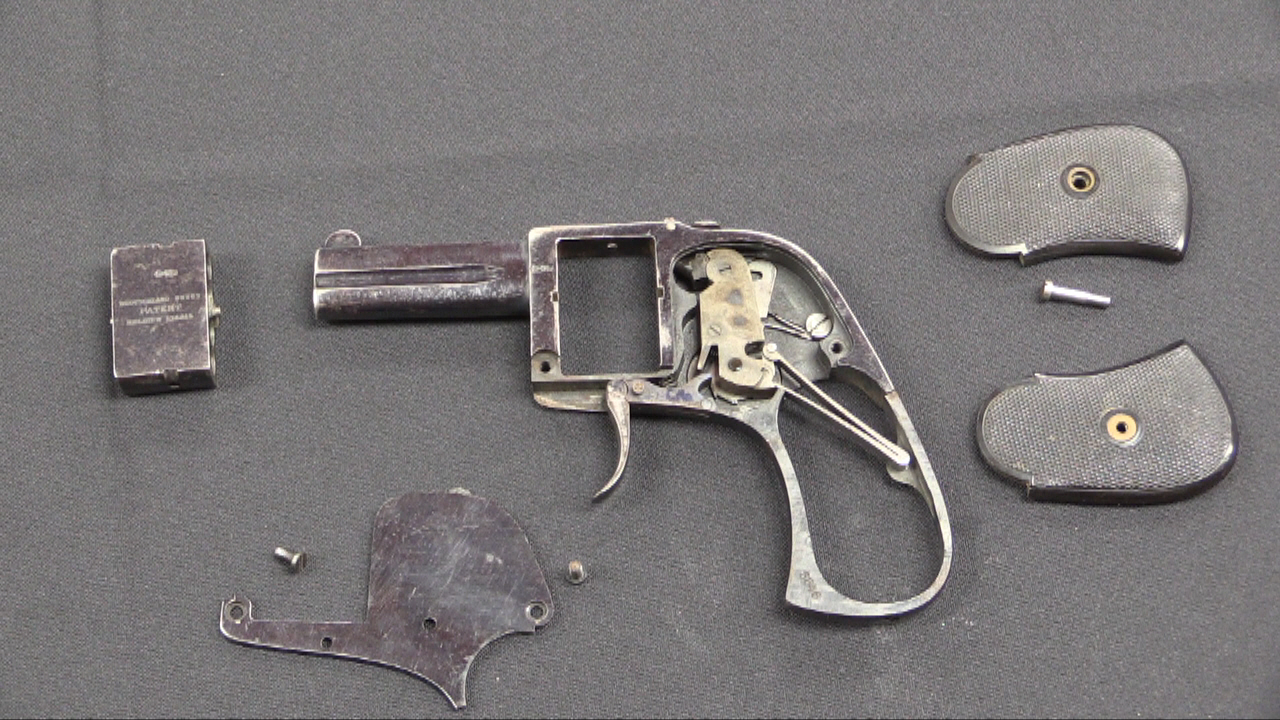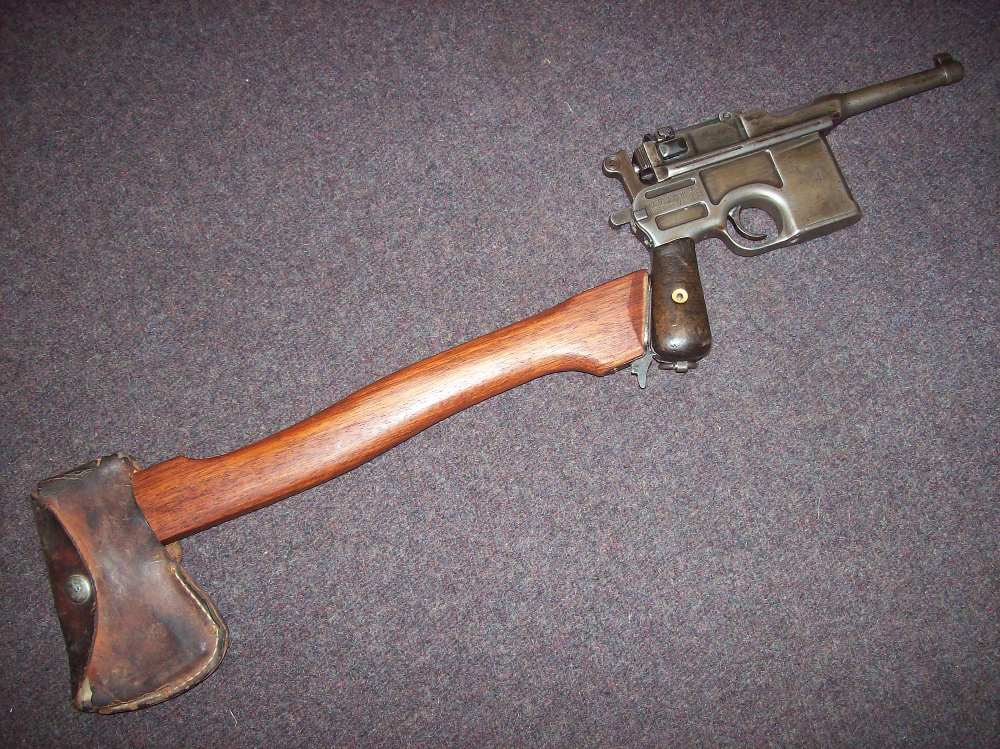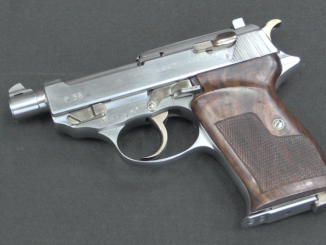https://youtu.be/ddNsrxe4ddY
Andreas Schwarzlose was a German designer who created several very interesting and unusual handgun designs (in addition to his 1907 heavy machine gun, which was adopted as a standard arm of the Austro-Hungarian military). His first handgun was the 1898 Standard Model, a short recoil, rotating bolt pistol that was remarkably ahead of its time but failed to sell well. This was followed by this experimental toggled locked 1901 prototype design.
The 1901 Schwarzlose is a toggle-delayed blowback system, but not in the same way as the Luger or Pedersen. It has a unique set of arms that provide a major mechanical disadvantage to delay opening when fired, unlike anything else. It also uses a torsion type of mainspring, which is also quite unusual in handgun design. All in all, a fascinating pistol!
When it failed to become commercially successful, Schwarzlose moved on to his 1908 blow-forward pocket pistol, which (remarkably) was the most successful of all his handguns.




This is the US Patent;https://docs.google.com/viewer?url=patentimages.storage.googleapis.com/pdfs/US804506.pdf
As stated in the patent text, this pistol, being very different from moving barrel locked breech toggle guns, uses a fixed barrel and as not clearly mentioned within the patent text, seems using the main “Momentum Convertion” principles granted via accelleration of the partial construction pieces getting a certain amount of momentum for the breechbolt delay system. The breechbolt transmits the gained momentum to the toggle arms as accerelating them through a long arc and distance and since wasting a lot of taken momentum to give motion to the toggle arms through short leverage force apply point, it slows. In fact, all automatic toggle guns get use of the advantage of this system. Though the construction seems awkward, the lay out and workmanship look as a masterpiece. The trigger/striker disconnection works in lateral order and seems the forerunner of today’s Glock connection and famous 1907 Schwarzlose machinegun looks as the continuation of this unsuccessfull pistol.
“famous 1907 Schwarzlose machinegun looks as the continuation of this unsuccessfull pistol”
So far I know, there were never lever-delayed automatic pistol produced in any quantity. As you can see in Schwarzlose 1901, most obvious placement of mechanism will result in “big overhang” shape, which is generally undesirable. But such solution is no problem in long arms, where lever-delayed is more often encountered: said Schwarzlose machine gun was adopted not only by Austria-Hungary but used and license-produced by Netherlands and Sweden (as Kulspruta m/1914), during First World War was supplied to allies of Austria-Hungary, after Fall of Austria-Hungary it was by multiple nations which emerged in effect of it – for example used and reworked for 7.9×57 cartridge by Czechoslovakia (těžký kulomet vz. 7/24).
Lever-delayed principle was also used in AA-52 machine gun and similar but bigger MAC-58 machine gun prototype (.50 BMG), where shape is not so important.
Toggle action blowback Erma and Stoeger pistols made in the last half of 20th Century, can be accepted as lever delay handguns by the approach of accerelating mass principles.
“Toggle action blowback Erma”
Can you name model? Erma produced various automatic pistols.
Erma KPG68,EL22, Stoeger l*g*r pistols and from the acceleration principle point of view mentioned above, accepting the rollers as different kind of levers, HK9 and Korriphlia pistols can be consideted as lever delay pistols as well.
I think we are mixing action categories a bit (and I hate to be purist). Ian says this is “toggle-delay-blowback” operation. What you address (and correctly describe) is “lever-delay-blowback”. Not exactly same, if similar in their essence, this being mechanical obstacle/ disadvantage imposed to their breech.
This resulted from continuous rebly posts. However, if joined lever delay blowback in a single title, toggle delay feature remains in as a subtitle by the cause of its all common momentum convertion principle.
IMHO.
@Strongarm
As far as discussion on how to distinguish both subclasses of Retarded (as opposed to Delayed) blow-back is concerned, my own view is that the difference is of subtle mechanical nature while both in fact at some point “convert momentum” to the desired effect. You may notice that while “lever-delayed” mechanism involves mainly bending of critical part, the “toggle-delay” involves mainly compression. In either case, the joints are exposed to shear/ bending stress, which is the least desirable.
Your contribution is appreciated and I always pay attention to it.
Dear Denny,
Thanks for clarification. Unfortunately l can not help to keep my mouth closed when a real matter of subject about firearm science arises.
“patent”
I found Schwarzlose patent for Automatic firearm with fixed barrel and locked breech – US1026609A:
http://www.google.ch/patents/US1026609
Was it implemented in reality or it never did go beyond drawing board?
I can see in this element of something which later crystalized in Pal Kiralyi’s mind and what became his delayed-lever blowback carbine. As much as this is little bit low on practicality, the testimony of creator’s ingenuity cannot be missed.
What I can see in general in A. Schwarzlose’s designs is multipurpose nature of components with objective to reduce their number. This is little bit of double edge sword (e.i. complexity and cost), but he had evidently clear objective on forefront of his efforts. Shame his success was reduced practically just to his machinegun; he was able to do lot more.
In sense of my last remark on the subject in should be “retarded” rather than “delayed” blow-back. Just trying to be consistent.
Very cool!
Bas Martens had the only pictures that I’ve seen of an actual pistol of this model, before this video. It is ultra rare.
The action is delayed blowback, accelerating the heavy joint and arms of that toggle provides sufficient inertia for the delay. The out of battery safety is a particularly nice refinement.
The Scwarzlose 1898 pistol is very much the precursor to the 1970s Automag.
Potentially, you could end up with a shorter action by having the toggle folded initially.
BTW: I, by accident, found this Russian patent:
http://www.findpatent.ru/patent/226/2261406.html
authors claims that their solution, allow shorter mechanism that in FAMAS rifle.
What do you think about that patent?
I only butcher one language, but going by the picture it looks quite similar to this one, assuming the picture is in full recoil.
I was looking at picture 2, and then found picture 1 which shows the toggle folded forward. BTW is that a fluted chamber?
lt looks an improvement over FAMARS design and should be registered afterwards. As understood from the drawings, the folding accerelator lever enables more force to quicken the lesser massed bolt carrier and by means, using a shorter mechanism. A clever approach but needs more parts and critical contact surfaces prone to wear through usage. lMHO.
I can’t follow what happens when pivot 10 rises and pivot 12 moves front to back.
lf understood correctly, the folding accelerator lever, enables to throw the carrier block more backward in a certain time interval than any single piece one, therefore giving more speed to the linked carrier and by means, leaving lesser momentum to the breechbolt resulting a slower breechbolt opening at instant when the highest pressure in the chamber presents. lMHO.
“lt looks an improvement over FAMARS design and should be registered afterwards.”
Authors claims it is closest to [automatic] pistol model B76 of Benelli and that they managed to get length [of mechanism] same as Heckler & Koch G3 and that their solution allows from 1:10 to 1:20 and beyond leverage.
Benelli M76 resemblance might be confusing since that construction might be considered as true locked breech by cause of presenting a counter recess in the receiver for the breechbolt to seat firmly in by the pressure of inertial mass of the slide or bolt carrier at instant of the highest pressure happens inside the barrel. This feature is stated clearly in the related patent.
Interesting, but not as compact/ integral as is case with Famas. As I recollect there is another delayed blowback mechanism design by an Armenian inventor. This also did not get anywhere, as clever as it may be. As it looks, militaries like positive gas operated systems.
“gas operated systems”
Authors of that patent claim it is simpler than classic gas-operated mechanism:
Упрощается конструкция по сравнению с классической газоотводной системой.
and easier to manufacture:
Большая технологичность изделия по сравнению с классической газоотводной схемой.
That may be so just as is the case with Vahan rifle; https://www.forgottenweapons.com/armenian-vahan-rifle/
Mechanically speaking, these and similar designs go away from need for gas mechanism and necessity to clean them, but the major disadvantage that they work in narrowly defined zone of conditions. Sometimes even type of ammo powder load/ bullet weight may alter their behaviour, not to mention intruding dirt and wear. Typically, they open breech rather abruptly.
“abruptly”
Authors claims that their solution is immune to too early opening
Повышается безопасность работы в затрудненных условиях эксплуатации в результате исключения случаев самоотпирания или преждевременного отпирания при отскоке затворной рамы (в случае автоматики с классическим газовым двигателем и полусвободных затворов типа FA MAS и Н&К) за счет большого передаточного отношения.
I feel I understand some 90% of it – it sounds quite ambitious. I will save the page for further study. Thank you Daweo.
Schwarzlose’s pistol designs were very sophisticated, but also extremely difficult to machine with the state of the art of the day. Put simply, the Standart was so expensive to make that the firm lost money on every one that left the plant. This one would have been no cheaper to manufacture.
Schwarzlose’s 1908 blow-forward was a bit cheaper to make, but still a bit more expensive to manufacture than its blowback counterparts (FN M1900 and M1910, Colt M1903, etc.).
It also had one purely subjective drawback. It kicked like a mule.
Schwarzlose’s decision to concentrate on heavy machine-gun design and manufacture was very likely a shrewd one from a purely business POV. War clouds were gathering in Europe and elsewhere well before 1914; as one historian (Dr. John d. Clark) put it, Theodore Roosevelt was making indiscreet remarks and building battleships, and Kaiser Wilhelm of Germany was building battleships and making indiscreet remarks.
In such an environment, HMGs were more likely to be money-mskers than highly sophisticated handguns.
The “Schwarzlose curse” affected gun makers here, too. The Grant Hammond/High Standard .45 caliber automatic of 1910-11 was remarkably similar to the Standart in design, and failed in the U.S. Army trials mainly due to being a lot more expensive to make than the Browning-designed Colt automatic pistol.
Half a century later, the Auto Mag pistol, based on the Grant Hammond design, was a technical tour de force and a commercial failure. At the end of its production in 1974-75, it listed for $400, and Harry Sanford later admitted that they were losing about that much on each pistol from a “break-even” point; to make a profit, it would have had to sell for about three times that.
Today, with CAD/CAM and 3d printing/manufacture, I wonder if such designs could be produced and sold economically?
I would find a reproduction Standart in 7.62 x 25mm, made of modern materials, very interesting. And an Auto-Mag chambered for something like 9mm Winchester Magnum even more so.
cheers
eon
“Kaiser Wilhelm (…) indiscreet remarks”
Wilhelm II has plan to invade United States
http://peashooter85.tumblr.com/post/110300181109/wilhelm-iis-plan-to-invade-america-by-the-late
“difficult to machine”
It is more complicated than Repetierpistole M.7?
“Schwarzlose’s 1908 blow-forward was a bit cheaper to make, but still a bit more expensive to manufacture than its blowback counterparts (FN M1900 and M1910, Colt M1903, etc.).”
I guess, that if you want big success of innovative automatic pistol (or any other innovative fire-arm), key is to found well-known (and trusted) fire-arm producer, which would be seen as guarantor of quality and have money for advert printing, take for example Mauser C/96 – first widely commercially successful automatic pistol – it was produced by well-known firm (Mauser Werke).
But on the other hand having reasonable design and established firm don’t guarantee success – take for example S&W and their Model 1913 automatic pistol.
“Today, with CAD/CAM and 3d printing/manufacture, I wonder if such designs could be produced and sold economically?”
I fully agree with point of your question. Both of those tools proved to have immense potential. I personally cannot imagine to draw and evaluate anything without use of solid modelling.
When comes to manufacturing, we have methods which did not exist then, such as lost wax casting or MIM, not to mention new grades of steels.
“lost wax casting”
This technology was known before 1901.
https://en.wikipedia.org/wiki/Lost-wax_casting
lt is said that lost wax or investment casting history extended into ancient Egypt. What changed from that ages to current times is the metallurgy and especially using mollibdeium element in alloys to get tougher steels with physical features nearing to forging technology.
MIM process on the other hand should be considered as today`s science with development of heat conduction process using porous die cast initial units shrinking nearly one fourth at the final furnace process. e,
Hard to believe that the same man, who created incredibly ingenious model 98 is also author of this anathema. It seems to me he took on the toggle lock idea to see how far it can be pushed in pistol application. He needs to be (posthumously) congratulated for that effort.
Btw, the pronunciation of inventor’s name is just perfect.
Has anyone noticed that the rear block with the hollow circle is very similar to the Standard (1898) pistol rear receiver? In both pistols, the part is pinned into the receiver or rear block. I wonder if the part is the same size in both pistols.
You are correct SteveG; it serves the same purpose – it backs striker spring and it is in line with barrel’s bore.
As I am looking at this latter design closely I can see, in spite of vastly different conception (reason I used word “anathema”), that the train of thought is similar. Both share superb efficiency and simplicity.
Location and compactness of the recoil spring of this gun also needs a big applouse. Hats off Herr Schwarzlose.
That is definitely so and I also like it. The flipside is however, that this feature expands lower end of mechanism’s outline into intersection with hand web-index finger-thumb plane thus making it little less “ergonomical” (forcing grip into unnatural form).
Yet, it is a matter of perception if this on balance is worth it, as opposed to an alternate main spring location. I am not sure one way or the other.